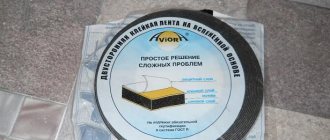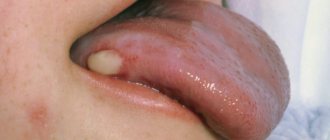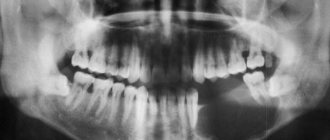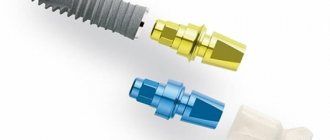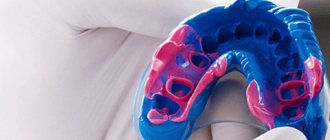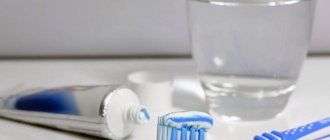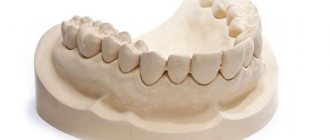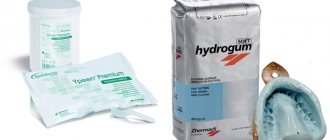High-precision one-stage diagnostic impressions made of C-silicone
N. I. Vasiliev , orthopedic dentist, dental clinic “ReSto”, Izhevsk
C-silicone impression materials are hydroxyl-terminated polydimethylsiloxanes that form a three-dimensional structure by polycondensation. Once a cutting-edge achievement in dental materials science, it has received widespread and positive reviews. Today they continue to hold the title of widely used impression materials, but have already been replaced by more advanced A-silicones, polyester impression compounds and combinations of the last two.
As it is cheaper, in contrast to A-silicones, and acceptably stable in volume, capable of long-term transportation, C-silicone is quite suitable as an ideal material for diagnostic impressions and impressions for auxiliary models.
Sufficient detail in models obtained from this material can only be achieved by using a fluid corrective phase. The two-stage impression obtained in this way is time-consuming and does not at all simplify the patient’s stay at the appointment, undergoing another insertion of the impression tray into the oral cavity.
In this article, the author shares his experience of one-step impression using both different fluid phases of C-silicones to obtain accurate models.
The first method of taking impressions is the simplest: using cling film or a plastic bag. The mixed bulk of C-silicone is placed in a spoon and covered with a layer of cling film, pre-cut to the approximate shape of the spoon (Fig. 1). The impression mass, which has not yet been polymerized, is imprinted through the film on the dentition (Fig. 2). The dentist's task is to take an impression of the teeth at almost their full height and accurately position the tray in the oral cavity. The film is then removed and a fluid correction is applied to the printed form, which is immediately applied to the dentition. The tray, individualized in this way, is an excellent imitation of a two-stage cast (Fig. 3). You should pay attention to the fact that the manipulations of placing the main mass in a spoon, gluing the film and printing through it should be carried out simultaneously with mixing the corrective silicone. The introduction of a spoon into the oral cavity with a liquid phase should be within the range of the elastic working time of the main mass of C-silicone (Fig. 4, 5).
Fig. 1. The mixed bulk of C-silicone is placed in a spoon and covered with a layer of cling film.
Figure 2. The bulk of silicone printed through film.
Fig. 3. The final impression after adding a fluid corrective mass.
Figure 4. The one-step “through cellophane” impression technique demonstrates excellent detail of the anatomical features of the teeth.
Figure 5. The one-step “through cellophane” impression technique demonstrates excellent detail of the anatomical features of the teeth.
The second method begins by customizing a standard impression tray with a small amount of base material. In the upper jaw, it is placed on the palatal part, creating a so-called “palatal stop” and in the retromolar areas on both the upper and lower jaw tray (Fig. 6). In the tray on the lower jaw, you can create an additional positioning stop in the area of the incisors. The placed mass, which individualizes the standard tray, is imprinted and positioned in the oral cavity. Its excess, which has spread after printing into the area where the main mass is laid, is cut off (Fig. 7). The purpose of the described individualization of a standard tray is to create sufficient rheological pressure of the applied silicone on the tooth structure and surrounding soft tissues, preventing pull-ups.
Fig. 6. Individualization of a standard impression tray of the upper jaw with a small amount of base material, creating the so-called “palatal stop”.
Fig. 7. Excess silicone, which has spread into the area where the main mass is laid after printing, is cut off.
After the individualization of the standard tray is completed, the mixed base mass is introduced into it, in which a groove is created with a finger along the dentition (Fig. 8), and the synchronously mixed corrective phase is placed into the groove (Fig. 9). An impression is made (Fig. 10, 11).
Fig. 8. In the thickness of the laid main mass, a groove is created with a finger along the dentition.
Fig. 9. The corrective phase mixed synchronously with the main mass is placed in the groove.
Fig. 10. The final impression after adding a fluid corrective mass.
Figure 11. The one-stage impression technique in a customized standard tray demonstrates excellent detail of the anatomical features of the teeth due to precise positioning and sufficient rheological pressure of the impression material on the tooth structures.
If you carefully follow the instructions for mixing C-silicone and the recommendations given in this article, you will be able to obtain a highly accurate impression of the dentition, including the retromolar and post-equator areas of the teeth. The good rheological pressure created by customization will prevent the material from pulling back.
Own operational skills and possible errors must be identified by analyzing the quality of the resulting models.
Medical Internet conferences
Comparative characteristics of modern alginate and C - silicone impression masses
Belyankin I.A., Afanasyeva M.M., Aslanyan M.A.
Heads: assistant of the department Nelovko T.V., head of the department Eremin O.V.
FSBEI HE "Saratov State Medical University named after. V.I. Razumovsky" of the Ministry of Health of Russia
Department of Propaedeutics of Dental Diseases
Modern dentists are faced with choosing the most appropriate impression mass.
Purpose : to explore and compare the properties and purposes of modern alginate and C-silicone impression masses.
Materials and methods : 1) Alginates are a fine multicomponent powder that must be thoroughly mixed with water, rubbing against the walls of the rubber container for 40 seconds, hardens in 2-3 minutes. (Ypeen).
2) C - silicones: the base is a container with a mass and a hardener in a tube; a large tube with a correction mass and a second one with a catalyst. The base is intensively mixed with your fingertips until homogeneity is achieved for 30 seconds, the corrective is mixed on a notepad 1:1; hardens - 2.5-5 minutes. (Speedex).
Results: The alginate mass has a viscous consistency. Accurately reproduces the microrelief of oral tissues, but is inferior to C-silicones.
Advantages of alginate masses: Low cost; ease of use; acceptable accuracy of cast relief for removable dentures and temporary crowns.
Cons: Insufficient accuracy for solid-cast and metal-ceramic structures; strong and rapid shrinkage (after 15-20 minutes 1.5%); the need for immediate casting of the model; poor adhesion to the spoon.
Pros of C - silicone masses: Reasonable cost; sufficient accuracy for solid-cast and metal-ceramic structures, silicone keys; low shrinkage (after 1-3 days 0.1-0.5%); elasticity and strength; admissibility of disinfection; Possibility of casting models in 2 days.
Cons: Difficulty in accurately dosing the catalyst; single use of the impression; hygroscopicity; low hydrophilicity; insufficient adhesion to the spoon; the possibility of allergies; the need for manual mixing.
Conclusion: Alginate and C-silicone impression masses are widely used in modern orthopedic and therapeutic dentistry. Based on the analysis of the parameters, alginate masses are more suitable for the auxiliary jaw, and silicone ones for the working jaw. The properties of alginates are inferior to C-silicone materials.
How to replace silicones in natural cosmetics for hair and skin
You can replace silicones in your handmade cosmetics recipe with other useful actives, which you can buy in the Beurre store. Such components will not only provide an immediate cosmetic effect, but will also benefit your skin and hair.
In order to replace silicone in a recipe, it is necessary to understand for what purpose this silicone was introduced into the formulation: to improve the tactile properties of the cream, to facilitate emulsion with base oils, to distribute pigment, to create a “dry” oil, or to giving hair silkiness.
For example, silicones in hair recipes can be replaced with broccoli and crambe oils. Literally 1-2% of these oils in your shampoo or conditioner will give your hair shine and smoothness.
Broccoli oil
It is considered the least greasy oil due to the erucic acid in its composition. It does not weigh down the hair, makes it more manageable and makes combing easier. In creams, broccoli oil improves the glide and application of the product; due to its low fat content, this oil can be used in dry oil recipes for skin and hair. You can use pure broccoli oil as a treatment for the ends of your hair: take a few drops of the oil, rub it into your palms and then apply it to the bottom of damp hair.
Crambe butter
or Abyssinian mustard is also one of the lightest oils due to its fatty acid composition. They can replace silicones not only in hair recipes. Crambe oil is suitable for dissolving UV filters and provides good distribution of dry particles. Crambe oil is similar in terms of fatty acids to broccoli oil, one is much cheaper, and is often used in dry body oils, as well as massage mixtures.
You can replace dimethicone in hair products with the innovative active Sofcare
. It is a multifunctional conditioning ingredient of plant origin. It does not reduce hair volume (as silicones do), enhances its shine and improves hair manageability, and helps the hairstyle maintain its shape. At the same time, Sofkea enhances the strength of hair. It is evenly distributed throughout the hair, promotes better adhesion of the cuticle to the hair shaft, thereby improving the condition of brittle hair. And a bonus for everyone who cares about the planet - the component is biodegradable and does not harm the environment.
Volatile silicones, for example the popular cyclomethicone, are the main component of leave-in dry oils for skin and hair, and are also a frequent guest in cream formulations. Its task is to lighten oil mixtures, make them easily distributed over the body and hair, and quickly absorbed. In creams it improves tactile properties and makes them light and instantly absorbed. However, synthetic cyclomethicone can be replaced with natural analogues: emollients Gosulin IL
and
Cetiol RLF
. These are super light, volatile emollients with high spreadability. Both of them are able to lighten oil mixtures, reduce fat content, promote better distribution of the cosmetic product and improve tactile sensations. At the same time, these emollients really soften the skin and can even be used in children's cosmetics, because they are of plant origin.As for phenyl trimethicone, which is often used in recipes for lip products (lipsticks, glosses, balms) to give them shine, it can be replaced with the ceramide-like emollient Eldew
. This component significantly enhances the shine and radiance of decorative cosmetics, improves the overall impression after application, and also carefully cares for the skin of the lips.
We often use all these components to create recipes from the Beurre cosmetic kitchen. You can watch them on our youtube channel
, get inspired and create your own recipes. Use components thoughtfully, read their descriptions and do not chase an instant effect.
